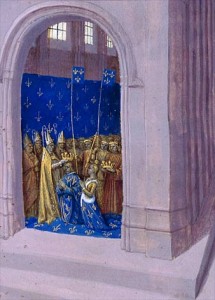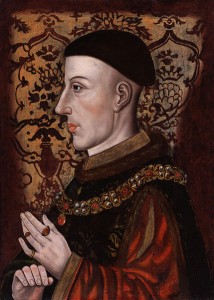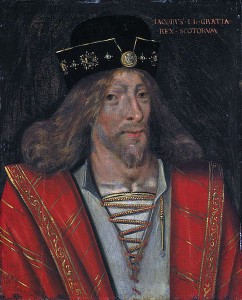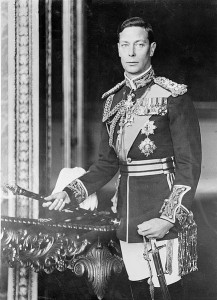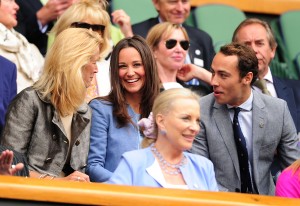
Pippa and James Middleton, siblings of the Duchess of Cambridge in the Royal Box, seated behind Princess Michael of Kent. Photo credit: PA photos
Pippa and James Middleton, joined Prince and Princess Michael of Kent in the royal box today for the first day of The Championships, Wimbledon. The Middletons and the Kents are all tennis enthusiasts.The Queen’s cousin, Prince Edward, Duke of Kent is the President of the All England Lawn Tennis and Croquet Club and his brother and sister-in-law, Prince and Princess Michael of Kent are often present in the royal box for the Wimbledon Championships.
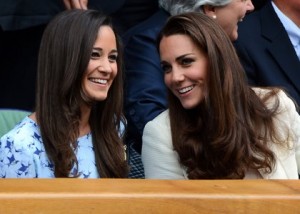
The Duchess of Cambridge and her sister Pippa Middleton attending the men's final at Wimbledon in 2012.
The Duchess of Cambridge and her younger siblings, James and Philippa (Pippa) have played and watched tennis since childhood. In her recent column for Vanity Fair, Pippa Middleton reminisced about lining up for Wimbledon tickets with Kate. She wrote, “One of my favourite Wimbledon experiences was queuing from 5am on People’s Sunday in 2004 with my sister for three hours and getting £35 tickets on Centre Court – my first time ever.”
When William and Kate briefly broke up in 2007, the press photographed Kate picking up her tennis racquet from her London flat, which was viewed as a sign that she was carrying with her life without the Prince. The Middleton siblings and William currently play at The Queen’s Club in London. In January 2013, the Duchess of Cambridge was made an honorary member of the All England Club and there are reports that she will begin presenting the tournament trophies in 2014, succeeding the seventy-seven year old Duke of Kent.
Tennis has always been a popular sport with royalty. The first indoor real tennis court – a predecessor of lawn tennis similar to squash – was commissioned by King Louis X “the Quarreler” of France, who reigned from 1305 to 1314. Monarchs across Europe emulated the enclosed real tennis courts established by the King of France. Unfortunately, Louis X’s enthusiasm for tennis contributed to his downfall and that of the Capet dynasty. The King spent so much time on the tennis court that his neglected first wife, Margaret of Burgundy allegedly had an affair with one of her household knights, casting doubt on the paternity of her child, who was ultimately excluded from the succession.
Louis X remarried but he died suddenly in 1314 after drinking an excessive amount of chilled wine following a particularly vigorous tennis match. He wouldn’t be the last French monarch to lose his life in tennis related circumstances. In 1498, King Charles VIII “the Affable” struck his head on a door lintel while on his way to watch a real tennis match in Amboise. Upon his return from the game, the King fell into a sudden coma and died. Despite these incidents, tennis remained a popular game for French royalty until the Revolution of 1789 when members of the Third Estate convened on a Versailles tennis court to swear and oath that they would not disperse until a new constitution was written.
In England, King Henry V was the first royal tennis enthusiast, inspiring a scene in William Shakespeare’s Henry V where the Dauphin Louis of France sends the King tennis balls instead of tribute. In the play, Henry V responds with an extended tennis metaphor about his planned invasion of France, declaring, “We are glad the Dauphin is so pleasant with us/His present and your pains we thank you for/When we have march’d our rackets to these balls/We will, in France, by God’s grace, play a set/Shall strike his father’s crown into the hazard./Tell him he hath made a match with such a wrangler/That all the courts of France will be disturb’d/With chaces.”
King Henry VIII was another enthusiastic tennis player, eager to show that his skill at the game was superior to his fellow monarch and rival, King Francois I of France. The King of England commissioned a real tennis court for Hampton Court Palace, which is still in use today. The original Tudor tennis court was renovated extensively by Charles II after his Restoration in 1660, adding a new floor and nets as well as velvet cushions for spectators.
The Hampton Court real tennis facilities, however, are not the oldest tennis courts still in use. In 1539, King Henry VIII’s nephew, King James V, the father of Mary, Queen of Scots, commissioned a real tennis court at Falkland Palace. As in France, tennis became a popular sport for royalty despite the death of a monarch in circumstances related to the game. In 1437, King James I of Scotland ordered that an underground tunnel from Blackfriars Monastery in Perth be blocked up because his tennis balls were disappearing down the entrance. The King was murdered in the tunnel later that year, unable to escape from assassins who had broken into the monastery to commit regicide.
Royalty throughout Europe continued to be tennis enthusiasts with the emergence of the modern game of lawn tennis in the nineteenth century. From its first tournament in 1894 until the outbreak of the First World War, the Homberg Cup in Germany attracted royal spectators including the future King Edward VII, Grand Duke Ernst-Ludwig of Hesse, Crown Prince Constantine of Greece and Grand Duke Mikhail Alexandrovich of Russia, brother of Czar Nicholas II.
Major British and European tennis tournaments also attracted the occasional royal contender. In 1926, King George V’s second son, the Duke of York (the future George VI) entered the men’s doubles tournament at Wimbledon when Sir Louis Greig qualified and selected the Duke as his partner. Greig and the Duke were defeated in three sets by their first round opponents Arthur Gore and Herbert Roper Barrett.
The current Queen appears to have little interest in tennis. Despite serving as royal patron of the All England Tennis Club, the Queen has only attended the Wimbledon Championships twice during her reign. The enthusiasm for tennis displayed by both the Kents and the Middletons continued the centuries long relationship between royalty and the game of tennis. The Duke and Duchess of Cambridge’s first child, due next month, will undoubtedly receive tennis lessons, carrying on the family tradition.
